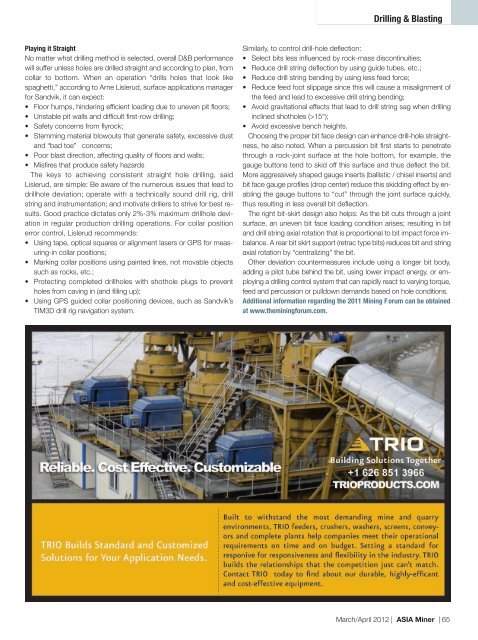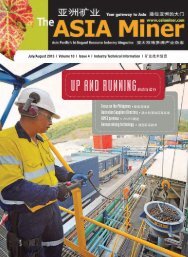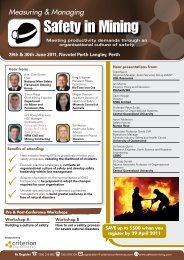Volume 9 Edition 2 2012 - The ASIA Miner
Volume 9 Edition 2 2012 - The ASIA Miner
Volume 9 Edition 2 2012 - The ASIA Miner
You also want an ePaper? Increase the reach of your titles
YUMPU automatically turns print PDFs into web optimized ePapers that Google loves.
Drilling & Blasting<br />
Playing it Straight<br />
No matter what drilling method is selected, overall D&B performance<br />
will suffer unless holes are drilled straight and according to plan, from<br />
collar to bottom. When an operation “drills holes that look like<br />
spaghetti,” according to Arne Lislerud, surface applications manager<br />
for Sandvik, it can expect:<br />
• Floor humps, hindering efficient loading due to uneven pit floors;<br />
• Unstable pit walls and difficult first-row drilling;<br />
• Safety concerns from flyrock;<br />
• Stemming material blowouts that generate safety, excessive dust<br />
and “bad toe” concerns;<br />
• Poor blast direction, affecting quality of floors and walls;<br />
• Misfires that produce safety hazards<br />
<strong>The</strong> keys to achieving consistent straight hole drilling, said<br />
Lislerud, are simple: Be aware of the numerous issues that lead to<br />
drillhole deviation; operate with a technically sound drill rig, drill<br />
string and instrumentation; and motivate drillers to strive for best results.<br />
Good practice dictates only 2%-3% maximum drillhole deviation<br />
in regular production drilling operations. For collar position<br />
error control, Lislerud recommends:<br />
• Using tape, optical squares or alignment lasers or GPS for measuring-in<br />
collar positions;<br />
• Marking collar positions using painted lines, not movable objects<br />
such as rocks, etc.;<br />
• Protecting completed drillholes with shothole plugs to prevent<br />
holes from caving in (and filling up);<br />
• Using GPS guided collar positioning devices, such as Sandvik’s<br />
TIM3D drill rig navigation system.<br />
Similarly, to control drill-hole deflection:<br />
• Select bits less influenced by rock-mass discontinuities;<br />
• Reduce drill string deflection by using guide tubes, etc.;<br />
• Reduce drill string bending by using less feed force;<br />
• Reduce feed foot slippage since this will cause a misalignment of<br />
the feed and lead to excessive drill string bending;<br />
• Avoid gravitational effects that lead to drill string sag when drilling<br />
inclined shotholes (>15°);<br />
• Avoid excessive bench heights.<br />
Choosing the proper bit face design can enhance drill-hole straightness,<br />
he also noted. When a percussion bit first starts to penetrate<br />
through a rock-joint surface at the hole bottom, for example, the<br />
gauge buttons tend to skid off this surface and thus deflect the bit.<br />
More aggressively shaped gauge inserts (ballistic / chisel inserts) and<br />
bit face gauge profiles (drop center) reduce this skidding effect by enabling<br />
the gauge buttons to “cut” through the joint surface quickly,<br />
thus resulting in less overall bit deflection.<br />
<strong>The</strong> right bit-skirt design also helps: As the bit cuts through a joint<br />
surface, an uneven bit face loading condition arises; resulting in bit<br />
and drill string axial rotation that is proportional to bit impact force imbalance.<br />
A rear bit skirt support (retrac type bits) reduces bit and string<br />
axial rotation by “centralizing” the bit.<br />
Other deviation countermeasures include using a longer bit body,<br />
adding a pilot tube behind the bit, using lower impact energy, or employing<br />
a drilling control system that can rapidly react to varying torque,<br />
feed and percussion or pulldown demands based on hole conditions.<br />
Additional information regarding the 2011 Mining F orum can be obtained<br />
at www.theminingforum.com.<br />
March/April <strong>2012</strong> | <strong>ASIA</strong> <strong>Miner</strong> | 65
















